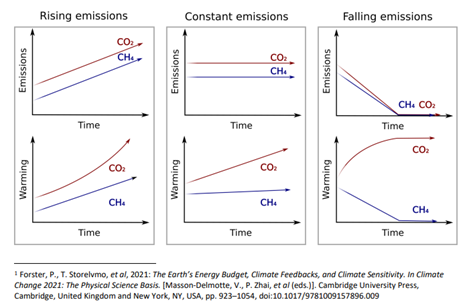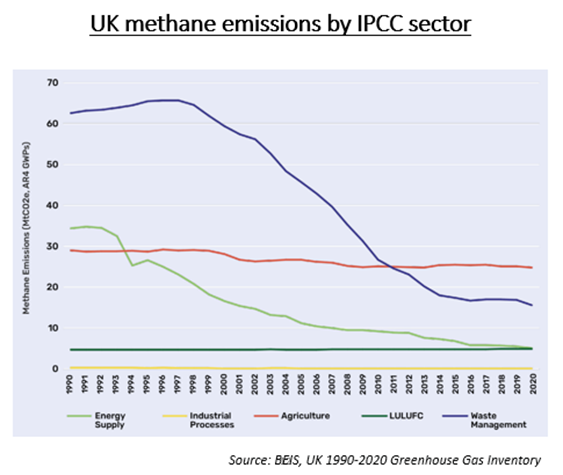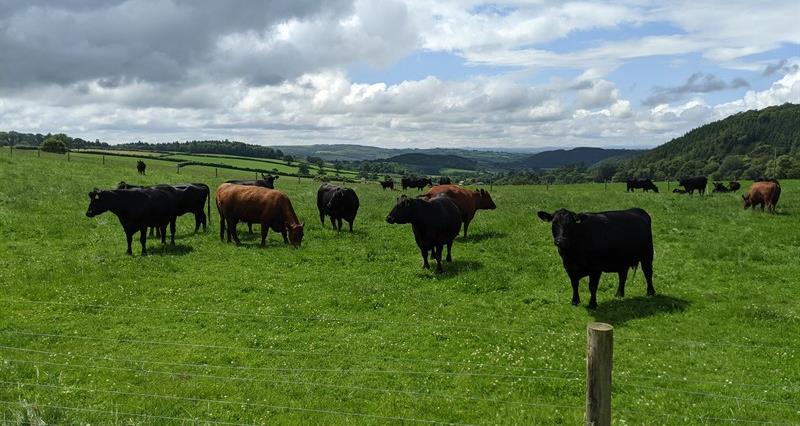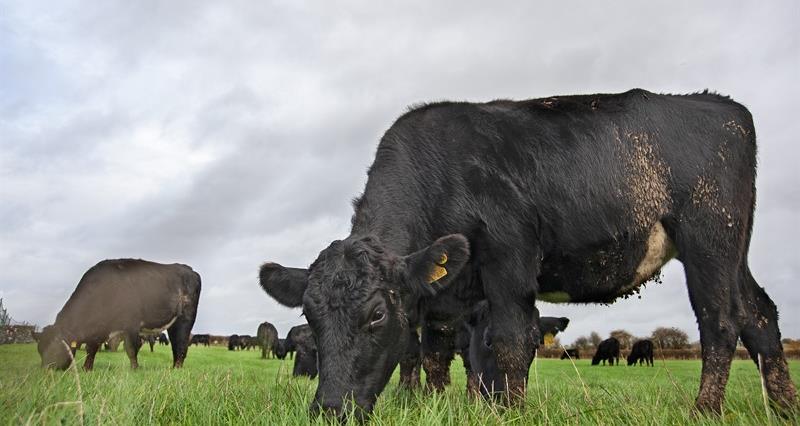Different GHGs (greenhouse gases) have different effects on climate change, known as radiative efficiency or radiative forcing. GWP stands for global warming potential and measures the average forcing over time rather than at any point in time.
GWP* is usually written with an asterisk to show that the GWP values being referred to have been adjusted to account for additional factors, such as different time horizons.
Methane is short-lived because it breaks down in about 12 years. It may also be described as a ‘flow gas’ being destroyed at a similar rate to its emission, and only causing warming for that 12-year period. CO2 is a ‘stock gas’, lasting in the atmosphere for hundreds of years.
How CO2 and methane (CH4) affects warming
GWP* reflects this relationship and is a more accurate metric for the warming impacts of methane. It relates the changes in the rate of emissions to cumulative emissions of CO2e.
Using GWP*, any increase in methane emissions causes substantial warming, whereas GWP100 understates the warming impact of new methane emissions. But maintaining or reducing methane emissions has a lower temperature impact than with GWP100 and may cause no warming or, with faster reductions, may reduce warming.
Methane from livestock is part of a biological process recycling carbon in the atmosphere. With reducing methane emissions, climate cooling is possible.

Accounting for methane
The UNFCCC (United Nations Framework Convention on Climate Change) has adopted GWP100 for international accounting purposes under the Paris Agreement and mandates the use of IPCC (Intergovernmental Panel on Climate Change) 2006 Guidelines. The UK Greenhouse Gas Inventory is compiled accordingly. Common metrics allows consistency and comparability across nations in reporting emissions over time. The UK could report extra information using other metrics from IPCC reports. You will see GHG emissions measured in units of MtCO2e – metric tonnes of all GHG emissions expressed as carbon dioxide equivalent.
Based on a GWP100 (global warming potential over 100 years), 1 tonne of CH4 equates to 28 tonnes of CO2e. GWP100 overstates the effect of constant methane emissions on global surface temperature by a factor of 3-4 but understates the effect of any new methane emissions by a factor of 4-5 over the following 20 years.
GWP20 is an alternative metric, averaging the warming potential over 20 years. Over the shorter time span, GWP20 equates 1 tonne of CH4 to 87 tonnes of CO2. This significantly increases the contribution of methane to agricultural emissions because it does not account for methane breaking down in the atmosphere after that 20-year period.
GWP* has not yet been formally adopted by international climate scientists, but it was suggested by the Intergovernmental Panel (IPCC) in 2021 that policymakers should use the GHG metric they think is best. The IPCC states, ‘The choice of metric and time horizon can affect the distribution of costs and the timing of abatement between countries’. Further discussions on the science and policy implications will continue at COP28 but movement on these complex issues can be slow.
GWP* and farming
As part of the answer to climate change, UK livestock continues to reduce GHG emissions. The question is which metric will trigger the most effective change. GWP* should not divert attention from taking action; instead, policy could actively incentivise actions if the temperature impact of methane reductions was valued.
As GWP* uses 20 years of aggregate data the results from individual farms can be very different compared to the national herd or flock. For example, buying a neighbouring farm would have an impact on your footprint under GWP* although it makes no difference to the national inventory.
Every farm should have the ability to grow their business. The national herd size varies from year to year, but overall we have a declining population in the UK. As it is gradually decreasing, a 10-year rolling average could be used. GWP* would show no contribution to climate warming in the UK GHG.
While it can be argued that gradually falling livestock numbers and increased productivity are not contributing to climate warming in the UK, this cannot be said globally where livestock numbers continue to rise.
Differing reporting systems
There is ongoing scientific debate over the how to measure GWP* accurately, which has resulted in multiple systems of reporting. The two most widely used are dual reporting and split gas.
Dual reporting
The NFU supports dual reporting and would like to see a unified approach with industry and government at a national scale. As outlined in the Dairy Roadmap, GWP* is useful for reporting aggregate emissions across sectors and to map global trends and targets. GWP100 is better used for benchmarking at farm level, as 20 years of data are needed for GWP* and not always available.
Split gas reporting
A split gas approach involves having different targets for each greenhouse gas. Split gas reporting could be used at farm level because it helps primary producers understand the difference and where they can make changes and reduce emissions on farm.
View from New Zealand
In 2019 the New Zealand Climate Change Act adopted new GHG emissions targets: net zero across all GHG emissions by 2050 and, separately, reduce biogenic methane to 24-47% below 2017 levels by 2050, including 10% below by 2030. This effectively introduces split gas targets.
However, Federated Farmers would like to see GWP* used so that emissions budgets and targets for both long and short-lived gases are aligned on a warming basis. Policies can then appropriately incentivise marginal reduction in warming. Using GWP*, the target would be 10% methane reduction by 2050.
What are the implications of using GWP*?
Introducing a new metric would require a revaluation of how we reach climate targets both nationally and internationally. It could also be difficult to agree.
It may also affect national climate ambitions and policy priorities for reducing GHG emissions. If methane emissions were rapidly reduced, this would show a drop in temperature impact under GWP*. GWP* could therefore be viewed as evidence to support the rapid reduction of livestock numbers to ‘buy some time’ for other hard-to-decarbonise industries to reduce GHG emissions.
However, without a large effort to also reduce CO2, that temperature benefit would be lost over time. Potentially, a shift of focus from CO2 to reducing short lived emissions in climate targets could lead to an impact of future warming for generations. Reducing livestock in one jurisdiction may simply result in ‘carbon leakage’ – offshoring our emissions to another location. In addition, those imports may have a higher GHG footprint so the impact on the climate is worse.
International equity
GWP* looks at the rate of change, comparing current day emissions with the past (20 years), rather than absolute emissions; this works well at a global scale. However at a national scale it could be seen to favour developed countries which have already reached peak emissions and punish developing countries with historically low emissions, but which are experiencing growth. For a developing country with increasing emissions, per capita total emissions may still be low, but using GWP* will show a high perceived per capita CO2e because of the recent increase in CH4.
Transparency
There is a danger of being seen as hiding behind a metric rather than concentrating on reducing emissions and could be construed as moving the goalposts or even greenwashing.
What the livestock sector needs
CH4 is not the whole story; other environmental impacts should be taken into account such as nutritional value, ammonia emissions, water quality, biodiversity, habitats, and animal welfare. Consumers need balanced messaging not only through a more accurate picture of temperature impacts from livestock farming, but also on all of the above co-benefits.
The issue with methane
UK agriculture accounts for 48% of methane nationally and as other sectors reduce emissions, this proportion could increase.
Methane also comes from oil and gas flaring and leaks, fracking, landfill and rice paddies. 32% of human-caused global methane comes from livestock. Meat and dairy account for 14.5% of global GHG emissions, half of which is ruminant methane (24% N2O and 26% CO2).



